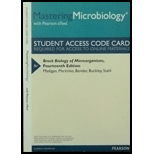
Concept explainers
Viral and bacterial respiratory pathogens are spread by means of air. Majorly, respiratory pathogenic organisms are transmitted from one person to the other through respiratory aerosols. An infectious aerosol is generated by sneezing, coughing, breathing, coughing, and by fomite contact or direct contact. The airborne pathogens affect both the upper and lower respiratory tracts.
Explanation of Solution
Gram-positive bacteria cause respiratory diseases more frequently compared to the Gram-negative bacteria. This is because, Gram-positive bacteria are highly resistant to desiccation, as they possess thick, rigid cell walls, which is absent in the Gram-negative bacteria. This characteristic ensures Gram-positive bacteria a better rate of endurance, when dispersed in the airborne droplets. As a result, Gram-positive bacteria cause more frequent respiratory infections than the Gram-negative bacteria.
Want to see more full solutions like this?
Chapter 29 Solutions
Brock Biology of Microorgan. -Access
- Why do gram-positive bacteria not produce endotoxins?arrow_forwardHow do microbes differ in their response to oxygen levels? Why would they differ? What enzymes are needed to adapt to environments containing differing amounts of oxygen?arrow_forwardOut of the 5 possible oxygen requirements (Obligate aerobes, microaerophiles, etc), what specifically is E. coli, Pseudomonas aeruginosa, and Clostridium sporogenes?arrow_forward
- Does the causative agent of tuberculosis, Mycobacterium tuberculosis, form spores thus making it very difficult to control? YES, it sporulates NO, it does not sporulatearrow_forwardWhy are Bacillus infections commonly associated with exposureto soil and dust?arrow_forwardWhat might an infection by Gram-negative bacteriabe more difficult to treat than a Gram-positive bacterial infection?arrow_forward
- Does Staphylococcus Epidermides produce hydrogen sulfide gas?arrow_forwardWhat do Gram positive bacteria generally possess and how will these help them in their virulence?arrow_forwardWould you expect to find the same typesof microorganisms associated with black smokerand carbonate vent systems? Explain.arrow_forward
- Given that so many infections are caused by gram-negative opportunists, what would you predict will happen as the number of compromised patients increases, and why do you make these predictions?arrow_forwardWhat is botulism?arrow_forwardwhat practical importance are air-borne microorganisms to the laboratory workers? What precautions should be taken to control laboratory contaminants?arrow_forward
